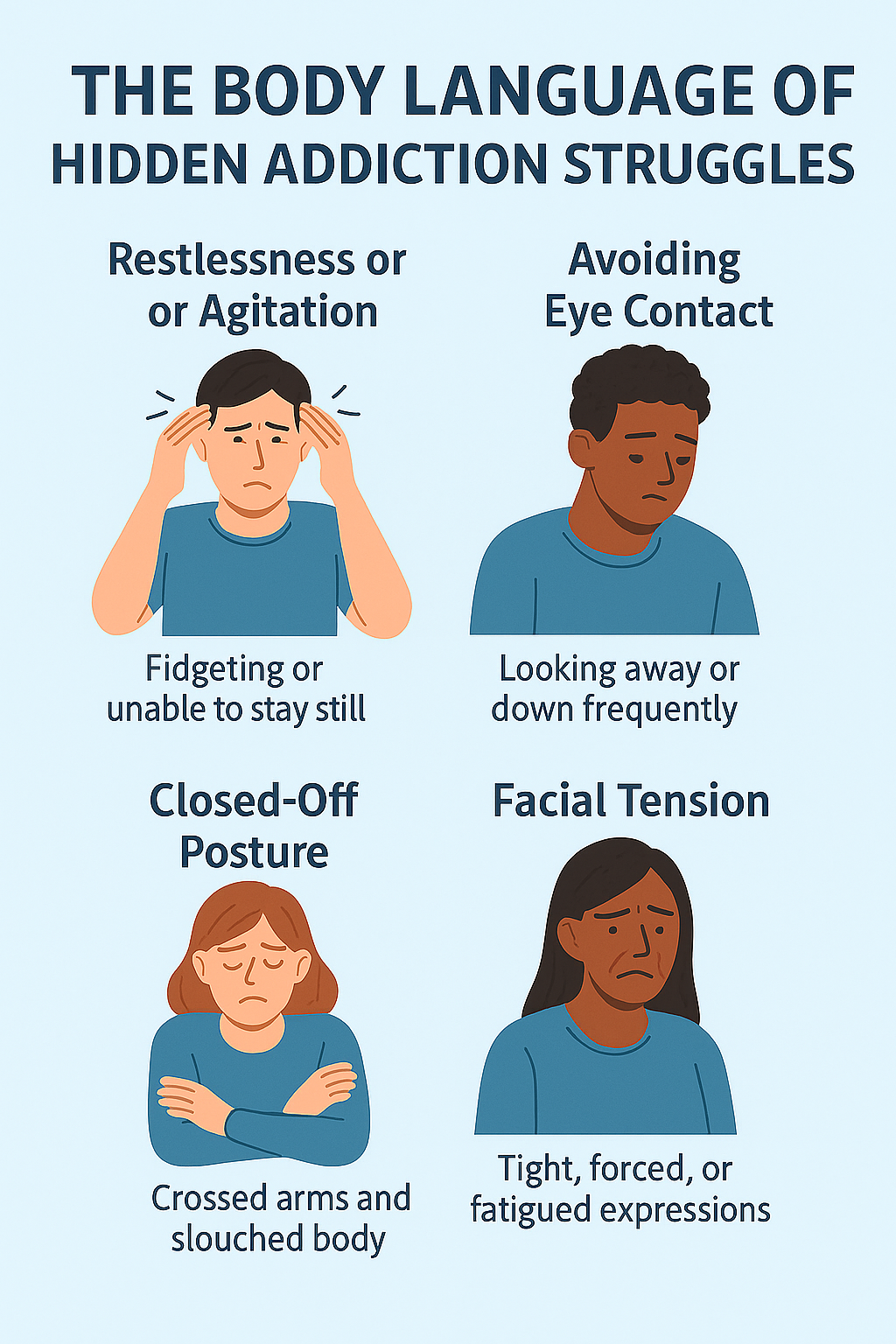If you know someone struggling with addiction, learning to read what’s not being said can be just as important as listening to their words. Body language often reveals emotions and struggles that a person isn’t ready—or able—to express openly. Small cues, such as avoiding eye contact, fidgeting, changes in posture, or even shifts in facial tension, can hint at inner turmoil or shame. Over the years, I’ve noticed how these subtle signals can speak volumes about someone’s mental and emotional state, especially when they’re trying to hide their pain or substance use. Recognizing these signs doesn’t mean judging or confronting; it means approaching with empathy and awareness. When you can see beyond the surface, you’re better equipped to offer meaningful support, initiate gentle conversations, and help someone feel seen and safe enough to seek help.
Spotting the Less Obvious Signs in Body Language
It’s easy to think that addiction always looks the same. Shaky hands, red eyes, or slurred speech are what most expect. Sometimes, signs are super subtle. Addictive behaviors can manifest in various ways, including gestures, posture, and even how a person avoids eye contact, as well as physical symptoms. I’ve noticed that people hiding addiction often get really good at masking what’s going on, so their body language might change just enough to give a clue, but never in an obvious way.
Understanding these quieter signals is helpful because not everyone struggling with addiction will tell you or act the way you might expect. A 2022 study from the Journal of Substance Abuse Treatment even points out that nonverbal cues can sometimes show more than verbal confessions. If you’re not sure, minor changes over time are often the most telling indicator. Over time, recognizing these signs becomes easier, enabling you to look beyond the surface and identify where someone might need support.
Common Body Language Indicators of Hidden Addiction
Spotting hidden addiction isn’t about jumping to conclusions based on one strange behavior: it’s about patterns. Here are some signs I often keep an eye out for:
- Withdrawing from Social Contact: Someone struggling with addiction might keep to themselves more, cross their arms, or angle away during conversations.
- Restlessness and Fidgeting: This may manifest as repetitive tapping, shifting weight, bouncing knees, or picking at objects. Restlessness that seems out of sync with the social setting can be a sign of withdrawal or anxiety related to substance cravings.
- Changes in Eye Contact: Addiction often brings discomfort, shame, or fear of being caught. Some people avoid direct eye contact to conceal their emotions, while others might stare too intently to compensate or mask their feelings.
- Unusual Grooming Habits: Messy clothes, stains, or a lack of interest in appearance aren’t always indicative of addiction, but if this is a new development for someone who previously cared about their appearance, it’s worth noting.
- Hands in pockets, Covering Mouth, or Hunched Shoulders: These can be protective gestures that subconsciously say, “Don’t look too close.” It’s often seen when someone is nervous or feeling exposed.
Protective Gestures and Defensive Actions: Beyond the basics, someone might keep a physical barrier, such as a bag or backpack, between themselves and others, or frequently adjust their clothing as if to wrap up or shield themselves. These can signal a desire to hide, both literally and emotionally.
Facial Expressions and Micro-Expressions
Our faces show a lot, sometimes for just a split second. Fear, guilt, or even excitement about using can flicker across a person’s face before they return to a neutral expression. Micro-expressions are super brief, but things like forced smiles, repeated grimaces, or darting glances give small clues that don’t always match up with what’s being said out loud.
Another thing I notice is how quickly someone’s face tenses up when specific topics come up, especially those related to personal routines or finances. Tension in the jaw, tight lips, or constant chewing on the inside of the cheek can show stress, discomfort, or even withdrawal symptoms.
Subtle facial changes can also include wandering eyes, furrowed brows, or biting their lips. Sometimes these patterns occur only for a moment but recur in specific situations, revealing underlying anxieties or emotional distress.
Changes in Posture and Physical Boundaries
How someone sits or stands reveals a great deal, especially if their posture has noticeably changed over time. People who are hiding things tend to take up less space. They might cross their arms tightly, cross their legs, or physically lean away from others during chat.
Pacing, standing near exits, or seeking out the corners of a room can sometimes indicate that they want to escape a situation quickly or aren’t feeling safe. While these moves are pretty standard for several reasons, noticing a pattern can be helpful.
Posture, too, can be revealing. Someone may transition from sitting upright and engaged to slumping more frequently or appearing tense in the shoulders for extended periods. Hunched shoulders and a tucked chin are physical attempts to shrink away from notice.
Personal Bubble and Space
Everyone has a comfort zone when it comes to personal space. If that bubble suddenly widens, as if a person consistently pulls away during hugs or leans back during conversations, they might be distancing themselves emotionally as well as physically.
Notice, too, if someone seems less inclined to initiate physical contact, or if they react with surprise or discomfort to normal social touches. Such shifts in their usual behavior can be clues to inner struggles.
Verbal and Physical Disconnects
There are times when what someone’s saying and what their body is doing don’t match up. This disconnect is particularly noticeable when discussing sensitive or challenging topics.
- Saying “I’m fine” with Tense Shoulders or Downcast Eyes: If the words don’t seem to match how the person looks or carries themselves, there’s likely something else going on.
- Changing Subjects Quickly: A quick subject switch when the conversation veers toward addiction, health, or finances often signals discomfort or a desire to keep secrets.
Watching for delays between speech and gestures, or overly quick, nervous laughter after serious questions, adds another layer to spotting what’s not being said. When you notice these disconnects, it’s a gentle reminder to listen to what isn’t being said just as much as the actual words.
Physical Health and Energy Levels
Addiction affects the body, but not always in the obvious ways shown in movies. I’ve noticed symptoms such as slumping, slower movements, or sudden bursts of hyperactivity. Some days, a person might seem super drained and disconnected, barely making it through the day, while other times they’re jumpy or overly chatty, especially if substances are involved.
If these changes persist or occur in cycles, paired with other body language signs, they’re worth keeping in mind. Fluctuations in appetite, sleepiness at unusual times, or frequent yawning—even changes in complexion—may all indicate patterns associated with deeper issues, mainly when observed alongside emotional withdrawal or changes in clothing choices.
Barriers to Spotting Body Language Clues
I find that reading body language isn’t as simple as ticking off boxes; it gets muddled by things like mental health, chronic pain, or even shyness. Someone who’s naturally awkward or anxious could look a lot like someone hiding addiction. That’s why checking for changes in a person’s usual pattern is so important. It’s not just about the actions, but about any changes in how they usually act around you.
Cultural background, previous trauma, and even neurodiversity all play a massive part in how people carry themselves. Careful, nonjudgmental attention is super important here. For example, in some cultures, avoiding eye contact is a sign of respect, not a clue for hiding something. Always keep these factors in mind before raising concerns.
What to Do When You Notice These Signs
Spotting signs is one thing, but determining the next course of action is just as important. Approaching someone with care, respect, and without judgment is really important. If you notice changes, focus on your concern for their well-being rather than on accusations to keep things compassionate. Express what you’ve noticed gently and give the person space to talk if they want to.
- Use “I” statements, like “I’ve noticed you’ve seemed a bit withdrawn lately. Is everything okay?”
- Offer support or resources, not lectures. Letting someone know you’re there can be powerful, even if they’re not yet ready to talk.
- Keep boundaries healthy. Your job isn’t to diagnose, but to listen and encourage help if needed.
Remember, bringing up your concerns isn’t about fixing everything immediately. Sometimes, just letting someone know they’re cared about and not alone opens the door for them to seek help when they’re ready.
Frequently Asked Questions
Here are some questions I often hear from people worried about a friend or loved one, and my honest thoughts on each:
Question: What’s the best way to tell if someone is hiding addiction?
Answer: Big, sudden changes in their usual behavior are what I pay attention to. No single gesture is proof, but if someone’s acting very differently and it doesn’t add up, trust your gut and look for patterns over time.
Question: Are there risks in confronting someone about addiction based on body language alone?
Answer: Yes, there can be. People are often sensitive or defensive if confronted without trust or clear evidence. It’s smart to approach any conversation with a focus on concern and care, rather than blame or assumptions.
Question: Can these body language signs indicate other problems?
Answer: Absolutely. Anxiety, depression, stress, and physical illness can all look similar through body language. It’s best to pay close attention to changes and to check in with the person rather than jumping to conclusions.
Why Knowing These Body Language Clues Matters
Understanding body language isn’t about catching someone out. It’s about noticing when someone might need help, even if they’re too scared or proud to ask for it. From what I’ve seen, the best support starts with observing, listening, and keeping a nonjudgmental attitude. Everyone deserves kindness and a safe space when they’re struggling.
If you’re hoping to help a friend, knowing what to look for can make a challenging situation a bit easier for both of you. When in doubt, patience, empathy, and a willingness to listen go a long way. Checking in and creating a safe environment for open conversation is sometimes the first spark toward real change.
Video: Can Body Language REALLY Reveal Hidden Addiction Struggles?

